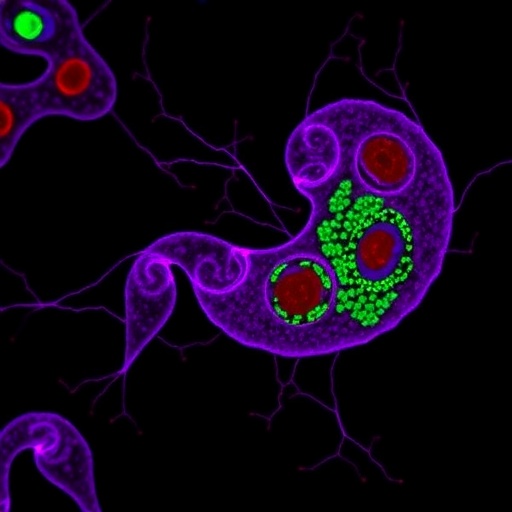
In the intricate landscape of cellular biology, the regulation of gene expression stands out as a pivotal process integral to all living organisms. A recent study by Gondane and Itkonen sheds new light on the dynamic interplay between O-GlcNAcylation and phosphorylation, particularly in the context of RNA polymerase II. This research delves into the molecular mechanisms that govern mRNA maturation, emphasizing the role these post-translational modifications play in cellular signaling and gene regulation.
Understanding mRNA maturation is vital, as it serves as the precursor to protein synthesis. This complex process involves several steps, starting from transcription by RNA polymerase II and culminating in the production of a mature mRNA molecule ready for translation. The study reveals that two key post-translational modifications—O-GlcNAcylation and phosphorylation—act on specific proteins associated with RNA polymerase II, influencing their binding affinity and functionality.
The authors propose that O-GlcNAcylation, the addition of N-acetylglucosamine to serine or threonine residues of proteins, serves as a marker for cellular nutritional status. This modification can modulate protein interactions and stability, creating a flexible regulatory mechanism. The study provides a detailed analysis of how alterations in O-GlcNAc levels can affect the recruitment of regulatory proteins to RNA polymerase II, thereby impacting mRNA processing.
Phosphorylation, on the other hand, is a well-established mechanism that modifies protein activity and behavior through the addition of phosphate groups. In the context of RNA polymerase II, the phosphorylation of serine residues in the C-terminal domain (CTD) can influence the transition from transcription initiation to elongation. Gondane and Itkonen’s research highlights how the competitive nature of O-GlcNAcylation and phosphorylation creates a nuanced regulatory environment that can change quickly in response to cellular signals.
Moreover, the study investigates how these modifications can attract or expel certain proteins from the RNA polymerase II complex, thus effectively controlling the mRNA maturation process. The dynamic nature of these interactions suggests a sophisticated regulatory network whereby cellular signals can lead to rapid changes in gene expression and protein production, providing cells with the ability to adapt to varying environmental conditions.
A particularly striking aspect of this research is the experimental approach utilized by the authors. Employing cutting-edge techniques such as mass spectrometry and live-cell imaging, the study effectively elucidates the dynamic changes in protein interactions that occur during mRNA maturation. This not only bolsters the credibility of their findings but also sets a precedent for future investigations exploring other aspects of gene regulation.
Furthermore, the implications of this research extend beyond basic biology; it offers potential therapeutic insights for diseases where mRNA maturation is disrupted, including various cancers and neurodegenerative disorders. Understanding how O-GlcNAcylation and phosphorylation interact could pave the way for novel intervention strategies aimed at restoring proper gene regulation in diseased states.
As we navigate through the mechanisms of cellular regulation elucidated in this comprehensive study, it becomes apparent that the interplay between O-GlcNAcylation and phosphorylation is crucial not just for basic cellular function but for the intricate balance of life itself. The ability of cells to fine-tune gene expression through such modifications underscores the complexity of cellular signaling pathways, and highlights a new frontier in our understanding of molecular biology.
In conclusion, the findings presented by Gondane and Itkonen mark a significant advancement in our comprehension of RNA polymerase II function and mRNA maturation. The study opens numerous avenues for further research, particularly in exploring how these regulatory mechanisms can be manipulated for therapeutic benefits. As the field moves forward, the significance of post-translational modifications like O-GlcNAcylation and phosphorylation cannot be overstated; they represent key players in the grand orchestration of cellular physiology.
The future of research in this domain holds great promise, as scientists continue to unravel the complexities of protein interactions and their implications in health and disease. The insights gained from this study not only contribute to the foundational knowledge of molecular biology but also inspire future endeavors aimed at leveraging this understanding in the development of innovative treatments and therapeutic approaches.
The work of Gondane and Itkonen thus serves as a cornerstone for aspiring researchers in the field, encouraging a deeper exploration of the dynamic regulatory mechanisms that govern gene expression and cell function. With such promising avenues of exploration on the horizon, the journey to discover the full potential of O-GlcNAcylation and phosphorylation in cellular biology is sure to yield exciting results in the years to come.
Subject of Research: The Dynamic Role of O-GlcNAcylation and Phosphorylation in mRNA Maturation
Article Title: Dynamic O-GlcNAcylation and phosphorylation attract and expel proteins from RNA polymerase II to regulate mRNA maturation.
Article References:
Gondane, A., Itkonen, H.M. Dynamic O-GlcNAcylation and phosphorylation attract and expel proteins from RNA polymerase II to regulate mRNA maturation.
J Biomed Sci 32, 39 (2025). https://doi.org/10.1186/s12929-025-01135-9
Image Credits: AI Generated
DOI:
Keywords: O-GlcNAcylation, phosphorylation, RNA polymerase II, mRNA maturation, gene expression.
Tags: cellular signaling mechanismsdynamic O-GlcNAcylationgene regulation dynamicsintricate cellular biology interactionsmolecular mechanisms in mRNA processingmRNA maturation regulationnutrient status and protein modificationsphosphorylation effects on mRNApost-translational modifications in gene expressionprotein synthesis precursor processesregulatory protein recruitment to RNA polymerase IIRNA polymerase II interactions




